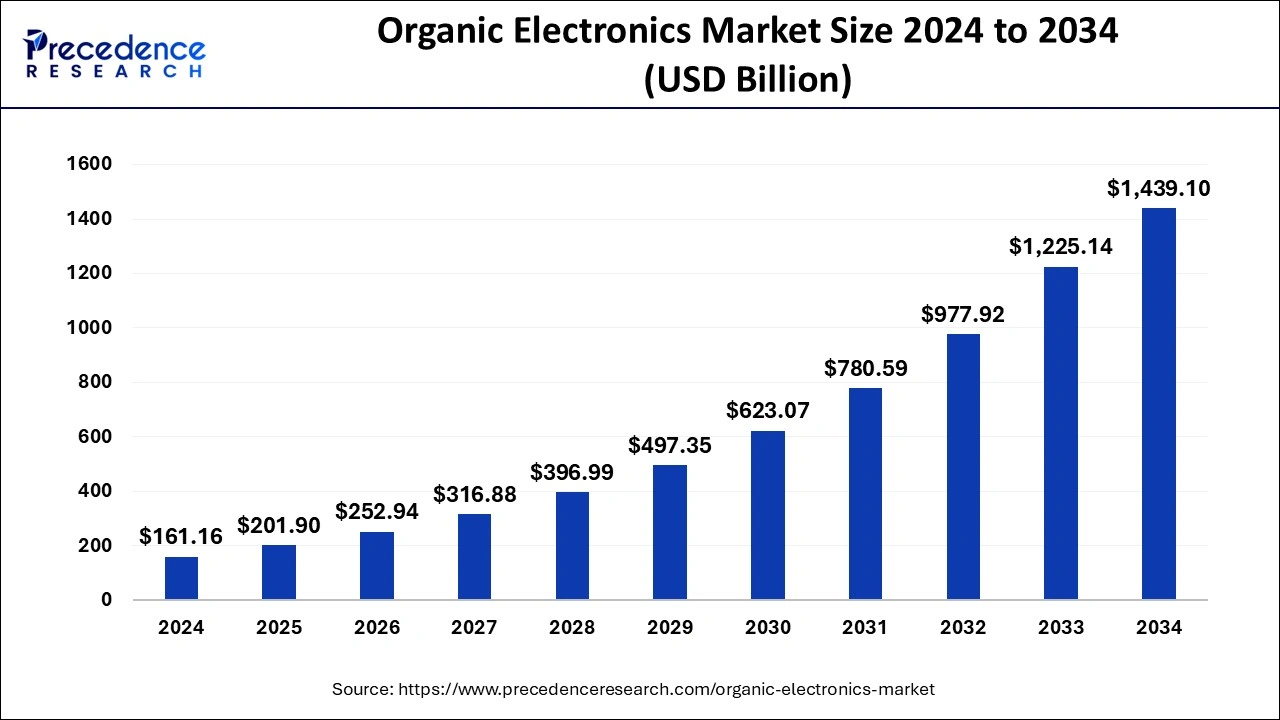Organic Electronics Market Size to Attain USD 1,439.10 Bn by 2034
The organic electronics market size accounted for USD 161.16 billion in 2024 and it is projected to attain around USD 1,439.10 billion by 2034 at a CAGR of 25.30%.

Table of Contents
ToggleKey Points
- In 2024, North America held a revenue share of approximately 37%.
- The semiconductor sector captured 35% of the revenue share in 2024.
- The consumer electronics segment comprised 32.4% of the total revenue in 2024.
Artificial Intelligence Driving Sustainability and Eco-Friendly Solutions
- AI optimizes material selection, reducing environmental impact in organic electronics.
- AI-driven energy management improves efficiency in organic solar cells and displays.
- AI-enabled recycling strategies support circular economy practices in the industry.
- Sustainable AI algorithms help minimize e-waste through smarter product design.
Get Sample Copy of Report@ https://www.precedenceresearch.com/sample/1134
Organic Electronics Market Growth Factors
1. Increasing Demand for Flexible and Lightweight Electronics
- The rise of foldable smartphones, flexible displays, and wearable devices fuels market growth.
- Organic electronics enable thin, lightweight, and bendable components, improving portability.
2. Advancements in OLED Technology
- OLED displays dominate the market due to superior color contrast, energy efficiency, and durability.
- Expanding use in televisions, smartphones, and automotive displays boosts demand.
3. Rising Adoption of Organic Solar Cells
- The push for renewable energy solutions increases demand for organic photovoltaic (OPV) cells.
- Lightweight and flexible solar panels drive adoption in smart buildings and IoT applications.
4. Expanding Applications in Healthcare and Wearable Devices
- Organic bioelectronics enable advanced sensors and medical wearables for health monitoring.
- Flexible electronics improve patient comfort and expand telehealth capabilities.
5. Growth in IoT and Smart Devices
- Organic electronics support miniaturized and energy-efficient IoT devices.
- Smart packaging, electronic skin, and printed RFID tags enhance connectivity solutions.
6. Sustainable and Eco-Friendly Technology Trends
- Organic electronics use biodegradable and non-toxic materials, reducing e-waste.
- Government policies promoting green technology encourage investment and adoption
7. Investment in R&D and Innovation
- Increased funding from governments and private firms drives new product developments.
- Innovations in printable and stretchable electronics expand market potential.
Read Also: https://www.newsgazzete.com/wearable-medical-devices-market/
Market Dynamics
Market Drivers
The demand for lightweight, flexible, and environmentally friendly electronic components is a key driver of the organic electronics market. OLED technology continues to gain traction in the display industry, with increasing applications in televisions, mobile devices, and automotive lighting.
Additionally, organic transistors and circuits are becoming more relevant due to their potential in low-cost, printable electronics.
Market Opportunities
The rise of the Internet of Things (IoT) and smart devices presents vast opportunities for organic electronics. Flexible, organic-based sensors and RFID tags are increasingly being used for real-time monitoring in industries such as healthcare, logistics, and retail.
The growing investment in organic solar panels also opens new avenues for the market, particularly in sustainable energy solutions. Furthermore, advancements in e-textiles and wearable electronics are set to revolutionize consumer electronics.
Market Challenges
Despite its promising potential, the organic electronics market struggles with production scalability and cost efficiency. High manufacturing costs and the limited lifespan of organic materials remain barriers to mass adoption.
Furthermore, integrating organic components with existing electronic infrastructures requires further technological advancements. Addressing these concerns will be crucial for the industry’s long-term success.
Regional Insights
Asia-Pacific continues to lead the organic electronics market, particularly in OLED display production and organic solar cell research. North America and Europe are witnessing growing interest in sustainable electronics, with companies investing heavily in biodegradable and flexible electronic materials.
Meanwhile, Latin America and the Middle East are gradually exploring the potential of organic electronics, especially in energy-efficient lighting and renewable energy projects.
Organic Electronics Market Companies
- BASF SE
- AGC INC.
- POLYIC GMBH & CO. KG
- Evonik Industries AG
- COVESTRO AG
- Heliatek GmbH
- C. Starck Inc.
- Novaled GmbH
- Merck KGaA
- Sumitomo Corporation
Segments Covered in the Report
By Material
- Conductive
- Semiconductor
- Dielectric
- Substrate
By Vertical
- Healthcare & Medical
- Military & Defence
- Industrial Automation
- Consumer Electronics
- Others
By Application
- 3D Printing
- Lighting
- Display
- Logic & Memory
- Conductive Ink
- Battery
- Sensors & Actuators
- Power Rources
- Others
By Regional
- North America
- U.S.
- Canada
- Europe
- U.K.
- Germany
- France
- Asia Pacific
- China
- India
- Japan
- South Korea
- Rest of the World
Ready for more? Dive into the full experience on our website@ https://www.precedenceresearch.com/
